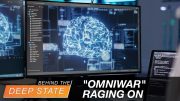Ever dreamed of being trained by a super-secret government agency to quickly identify the faces of “enemies” in fast-moving video footage? If so, then the Defense Advanced Research Projects Agency (DARPA) has a job for you.
According to an announcement posted on its website, DARPA is seeking “trailblazers” who want to “take the road less traveled” and “participate in a short-fuse, crucible-style environment to invent new approaches to the identification of people, places, things and activities from still or moving defense and open-source imagery.”
In simpler terms, the Pentagon wants bright college kids to help them design and perfect software that will allow government agents to quickly single out individuals from still photos and video footage of crowd scenes.
As with most government projects, this particular operation has been given an innocuous and meaningless name: Innovation House Study.
“A lot can happen when you put seriously intelligent, seriously motivated people in a room with a mission and a deadline,” said Michael Geertsen, DARPA program manager and the force behind the Innovation House Study. “We are inviting a new generation of innovators to try out ideas in an environment that encourages diverse solutions and far-out thinking. If this model proves to be as successful as we believe it could be, it represents a new means for participating in Government-sponsored research projects,” Geertsen said.
Government-sponsored research projects, indeed. The government will use public funds (taxpayer money) to entice university students to develop the next generation of software capable of allowing government agents to quickly and correctly spot any potential “enemy combatants” or “belligerents” from the thousands of other faces in a crowd.
The critical path reads as follows: Government unconstitutionally taxes the income of the people, then uses that money to pay some people to develop software that will make it easier to identify other people.
In this sinister scheme to find faster, more efficient ways to “protect the homeland,” DARPA is teaming up with the C4I Center at George Mason University. The following is the description of C4I provided on the George Mason University website:
Command, Control, Communications, Computing and Intelligence (C4I) systems are essential to our national security. History provides many examples of how C4I has influenced the outcome of an engagement or an entire conflict. In spite of its importance there is not an adequate intellectual base for the C4I area, and comprehensive educational programs in C4I do not exist in civil institutions.
To fill these needs, the Center of Excellence in C4I at George Mason University is the nation’s first and only civilian university-based entity offering a comprehensive academic and research program in military applications of information technology.
The center performs research in sensing and fusion, C3 architectures, communications and signal processing, command support and intelligent systems, modeling and simulation, and information systems. The center is allied with multiple academic departments, including Computer Science, Electrical/Computer/Telecommunications Engineering, Statistics, Systems Engineering and Operations Research. The last of these offers Master of Science in Systems Engineering with a major in C4I and also graduate certificates in both C4I and Military Operations Research.
Once again, the government is using money taken from the citizens of this country to fund the establishment of an omniscient, omnipotent surveillance state using the same old trope of “maintaining national security.”
The scope of the particular project (at least the publicly admitted scope) is set out in DARPA’s Request for Proposals:
DARPA’s Innovation House Study, conducted with George Mason University in Arlington, Va., will provide a focused residential research environment for as many as eight teams. Interested team leaders are encouraged to submit proposals by July 31, 2012, detailing their plan to design, execute and demonstrate a radical, novel research approach to innovation in the area of extracting meaningful content from large volumes of varied visual and geospatial media. Selected teams will receive up to $50,000 in funding.
What exactly is “geospatial media?” The dictionary defines “geospatial” as “pertaining to the geographic location and characteristics of natural or constructed features and boundaries on, above, or below the earth’s surface; especially referring to data that is geographic and spatial in nature.”
Wikipedia expands on the use of such geospatial analysis:
Geospatial analysis goes beyond 2D mapping operations and spatial statistics. It includes:
Surface analysis — in particular analysing the properties of physical surfaces, such as gradient, aspect and visibility, and analysing surface-like data “fields”;
Network analysis — examining the properties of natural and man-made networks in order to understand the behaviour of flows within and around such networks; and locational analysis.
Geovisualization — the creation and manipulation of images, maps, diagrams, charts, 3D views and their associated tabular datasets.
In order to assist these teams of surveillance software wunderkind in their mission to create a more robust recognition application, “DARPA will provide access to unclassified data sets and facilitate interaction with mentors from U.S. Government and academia. These interactions will provide teams with context for how their proposed technology could be applied in the realworld [sic].”
Furthermore, participating teams will “have access to mentors and visitors from academia and multiple U.S. Government agencies, including both military and intelligence communities’ specialists.”
Not surprisingly, the identity of the prospective mentors and visitors is not revealed by DARPA. Savvy readers can draw their own conclusions as to who might be interested in overseeing this special project.
Those vying for the DARPA contract will meet five days per week in an undisclosed “workspace” in Arlington, Virginia. The project lasts for eight weeks, and while it lasts, the developers will be put up in housing provided by George Mason University somewhere in the Arlington area.
And, just in case there’s some highly motivated team of college geospatial analysis whiz kids who worry that they just don’t have what it takes to compete against other equally ambitious squads of college engineers, DARPA has some words of encouragement:
This effort does not represent a competition between teams. Every team that demonstrates sufficient progress in the first session will continue into the second session. There is no limit to the capabilities that are needed in understanding large-scale imagery and video data, so all teams can be equally successful.
There’s room for everybody who’s willing to help the government explore all the limitless capabilities of analyzing “large scale imagery and video data.” So, anxious but reluctant colleges shouldn’t be intimidated by a little healthy competition. The government can use all the help it can get.
Finally, DARPA hints at the variety of media on which the various applications produced by the participating teams could be used:
Except for the requirement to produce software capabilities that obtain understanding from visual, geospatial and imagery-related data, there are no limitations on the applications, products, systems, modules, algorithms or any other software-realizable capabilities that may be proposed. They may run on any electronic systems, including but not limited to computers, tablets and mobile phones.
Again, there’s application for every field that might interest an up-and-coming software design genius. Cellphones, computers, tablets, you name it, and the government will willingly deploy it against its own citizens, so long as it is capable of “obtaining understanding.”
The deadline for submission is July 31, so interested teams should act now. As a bit of an incentive, DARPA will give $10,000 (again, taken from taxpayers) to those groups able to get their application submitted on time, and that money can be used in any way the team desires.




